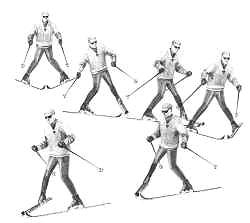


|
The drawing below shows the classic snowplow. Taken from Official American Ski Technique, Professional Ski Instructors of America (PSIA), New and Revised Edition, 1970.

|
For comparison here's a photo of former SMS Chair Nancy Gordon using the gliding wedge in the backcountry, from a video taken at the Blue Couloir near Mammoth in 1995. The snow was tricky mush and she is gliding over it using the modern turn.

|
In a modern wedge turn the skier is erect and balanced, not leaning to either side, steering both skis which are almost flat on the snow. The knees are not pushed together as in the snowplow, because the skis are flattened. At higher speed on a steeper slope, there is some edging of the outside ski to prevent skidding. The modern gliding wedge is opened and closed by pivoting the skis under the feet, not by pushing the tails out. The skier controls speed by turn shape, not by braking with the edges. The braking wedge is still used to stop or control speed in narrow places, but it is not taught as a method of turning.
The skills used in the gliding wedge apply directly to linked parallel or telemark turns. The late Allan Bard used to emphasize that backcountry skiers continually need every technique they ever learned. The wedge is not only for beginners. Every skier should practice it regularly.